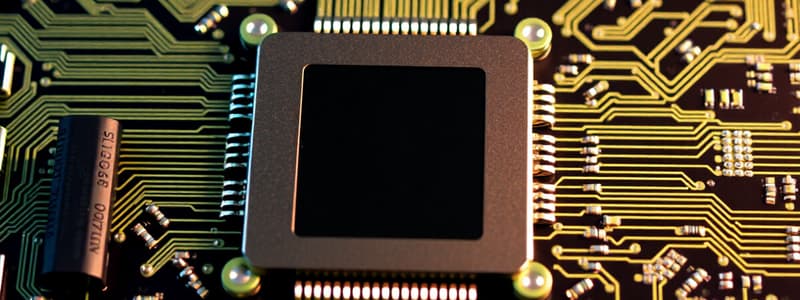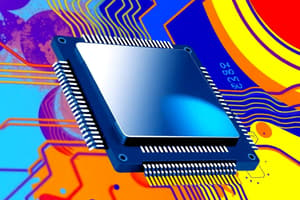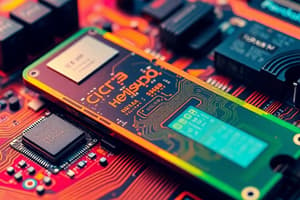Podcast
Questions and Answers
What is the primary function of a computer?
What is the primary function of a computer?
- To process information and execute instructions (correct)
- To store and retrieve data
- To communicate with other devices
- To display visual information
What type of electronic machine is a computer?
What type of electronic machine is a computer?
- Hybrid
- Analog
- Digital (correct)
- Mechanical
What kind of operations can a computer carry out?
What kind of operations can a computer carry out?
- Only arithmetic operations
- Only logical operations
- Both arithmetic and logical operations (correct)
- None of the above
What does the term "programmed" mean in the context of a computer?
What does the term "programmed" mean in the context of a computer?
What can be inferred about the Von Neumann architecture based on the provided context?
What can be inferred about the Von Neumann architecture based on the provided context?
What is the purpose of the CPU in a computer system?
What is the purpose of the CPU in a computer system?
What is the relationship between memory size and address size?
What is the relationship between memory size and address size?
How many memory locations can be addressed using a 3-bit address?
How many memory locations can be addressed using a 3-bit address?
What is the primary role of I/O devices in a computer system?
What is the primary role of I/O devices in a computer system?
What is a memory map?
What is a memory map?
What is the key principle behind the Von Neumann architecture?
What is the key principle behind the Von Neumann architecture?
What is a byte?
What is a byte?
What is the purpose of a bus in a computer system?
What is the purpose of a bus in a computer system?
What is the maximum number of values that can be represented by a double word (dw)?
What is the maximum number of values that can be represented by a double word (dw)?
Which of the following is NOT a representation of a signed integer number?
Which of the following is NOT a representation of a signed integer number?
Which of these is a valid hexadecimal representation?
Which of these is a valid hexadecimal representation?
In the 'fixed point' representation of a real number, what is used to represent the fractional part?
In the 'fixed point' representation of a real number, what is used to represent the fractional part?
What is the decimal equivalent of the binary number 11001011?
What is the decimal equivalent of the binary number 11001011?
Which of these is a coding convention used for character representation?
Which of these is a coding convention used for character representation?
What is the main difference between fixed point and floating point representation of real numbers?
What is the main difference between fixed point and floating point representation of real numbers?
What is the purpose of the 'sign bit' in signed integer representation?
What is the purpose of the 'sign bit' in signed integer representation?
Which of the following accurately describes the '2’s complement' method for representing negative numbers?
Which of the following accurately describes the '2’s complement' method for representing negative numbers?
What is the decimal equivalent of the hexadecimal number 0x5A?
What is the decimal equivalent of the hexadecimal number 0x5A?
What is the significance of a 20-bit address in memory?
What is the significance of a 20-bit address in memory?
What is the primary function of I/O devices?
What is the primary function of I/O devices?
What is the purpose of the Address Bus in a computer system?
What is the purpose of the Address Bus in a computer system?
Which of the following best describes the role of the Control Bus in a computer system?
Which of the following best describes the role of the Control Bus in a computer system?
What is the key difference between the Operating System and User Software?
What is the key difference between the Operating System and User Software?
Which of these accurately describes the role of the CPU in a computer system?
Which of these accurately describes the role of the CPU in a computer system?
What is the primary difference between 'flip-flops' in the context of information representation in computers?
What is the primary difference between 'flip-flops' in the context of information representation in computers?
What is the significance of the 'ports map' in a computer system?
What is the significance of the 'ports map' in a computer system?
Which of these options is not a key component of the System Bus in a computer system?
Which of these options is not a key component of the System Bus in a computer system?
What is the primary difference between the data stored in memory, and the data transmitted through the data bus?
What is the primary difference between the data stored in memory, and the data transmitted through the data bus?
Flashcards
Computer Definition
Computer Definition
A digital electronic machine programmed for operations.
Arithmetic Operations
Arithmetic Operations
Basic math operations like addition, subtraction, multiplication, and division.
Logical Operations
Logical Operations
Operations that involve comparison and logical decision-making.
Programmed Machine
Programmed Machine
Signup and view all the flashcards
Von Neumann Architecture
Von Neumann Architecture
Signup and view all the flashcards
CPU
CPU
Signup and view all the flashcards
Memory
Memory
Signup and view all the flashcards
I/O Devices
I/O Devices
Signup and view all the flashcards
Bus
Bus
Signup and view all the flashcards
Memory Location
Memory Location
Signup and view all the flashcards
Memory Map
Memory Map
Signup and view all the flashcards
Memory Size Equation
Memory Size Equation
Signup and view all the flashcards
20-bit Address
20-bit Address
Signup and view all the flashcards
Significance of Information
Significance of Information
Signup and view all the flashcards
I/O Ports
I/O Ports
Signup and view all the flashcards
Port Address
Port Address
Signup and view all the flashcards
System Bus
System Bus
Signup and view all the flashcards
Data Bus
Data Bus
Signup and view all the flashcards
Address Bus
Address Bus
Signup and view all the flashcards
Control Bus
Control Bus
Signup and view all the flashcards
Information Representation
Information Representation
Signup and view all the flashcards
Binary Digit
Binary Digit
Signup and view all the flashcards
Byte
Byte
Signup and view all the flashcards
Word
Word
Signup and view all the flashcards
Double Word
Double Word
Signup and view all the flashcards
Hexadecimal
Hexadecimal
Signup and view all the flashcards
Unsigned Integer
Unsigned Integer
Signup and view all the flashcards
Signed Integer
Signed Integer
Signup and view all the flashcards
Floating Point
Floating Point
Signup and view all the flashcards
ASCII
ASCII
Signup and view all the flashcards
Instruction Codes
Instruction Codes
Signup and view all the flashcards
Study Notes
Microprocessor Architecture
- This presentation covers the fundamental concepts of microprocessor architecture.
- The presenter, Horia Cucu, is from the Speech & Dialogue Research Laboratory, Faculty of Electronics, Telecommunications and Information Technology at the University POLITEHNICA of Bucharest.
1. The Architecture of a Computer
- 1.1 Definitions
- A computer is a digital electronic machine that can execute programmed arithmetic and logical operations.
- The Von Neumann architecture is a key computer architecture discussed. It involves the CPU, memory, and I/O ports interconnected by buses.
Block Diagram of Von Neumann Computer
- The Von Neumann architecture has three key components:
- CPU: Central Processing Unit
- Memory: Stores data and instructions
- I/O Ports: Allows interaction with external devices
- Control Bus: Communicates the commands between components
- Data Bus: Transports data between components
- Address Bus: Controls location of data/instructions
Functional Components
- CPU: Processes data and controls the system.
- Memory: Stores data in a sequential arrangement of memory locations.
- I/O Devices: Forms interfaces between the computer and external devices, enabling communication.
- Busses: Connections for communication between the other parts.
Von Neumann Principles
- Data and instructions are stored in memory.
- Data in memory is accessed through memory locations.
- The CPU processes data and controls the system.
- Instructions are fetched from memory and executed sequentially.
- I/O ports facilitate communication with other devices.
- Interconnection of all components is facilitated through the system bus.
The Memory – Basic Principles
- Memory is a sequence of memory locations used to store information.
- Each location is a byte (8-bit number) identified by a unique address.
- The CPU controls memory access, able to divide memory into logical segments (pages).
- The memory map represents the accessible memory locations.
- Memory map size is a performance criterion.
The Memory – A Closer Look
- Memory size depends directly on its address size (bits) following the equation: memory_size = 2address_size(bits).
- Example: A 2-bit address can represent 4 different locations (00, 01, 10, 11) in a 4-byte memory.
- Example: A 20-bit address in a memory provides 1MB of memory locations.
The Memory - Content Significance
- Each memory location stores an 8-bit value.
- Programmers determine the significance of the values.
- Memory has no inherent understanding of data meaning.
Input/Output Devices
- I/O devices are hardware blocks connecting the computer to the external world.
- I/O devices function as a set of I/O ports.
- Each port can send and receive data (8-, 16-, or 32-bit quantities)
- Ports are identified by a unique port address.
- The ports map comprises all addressable ports.
- The size of the ports map affects performance.
The System Bus
- A system bus comprises physical connections linking hardware blocks for information transfer.
- It facilitates the interaction between the CPU, memory, and I/O devices.
- The system bus has three components:
- Data bus (bidirectional, carrying data).
- Address bus (unidirectional, delivering addresses for CPU-memory communication).
- Control bus (bidirectional, carrying command and control signals).
The Software Component
- The software consists of programs or instructions that direct the computer’s operations.
- The software is categorized into two main parts:
- The Operating System: A set of programs facilitating user access to system resources.
- User Software: Programs specifically designed by the user to accomplish tasks.
Summary
- CPU: Executes instructions and controls system operation.
- Memory: Stores both data and instructions.
- I/O devices: Interconnects computer to the external world.
1.2 Information Representation in Computer Systems
- Information is stored using flip-flops (electronic switches) with on/off states.
- Bits (binary digits) represent 0 or 1 (Boolean values).
- Data types (e.g., bytes, words, double words) are sequences of bits.
- Byte (8 bits): Can hold 256 different values
- Word (16 bits): Can hold 65,536 values
- Double word (32 bits): Can hold 4,294,967,296 values.
The binary, decimal and hexadecimal bases
- Binary (base 2), decimal (base 10), and hexadecimal (base 16) represent numeric information.
- Hexadecimal numbers often use a suffix "h" (e.g., 1A44h).
Numbers representation
- Unsigned integers ("natural binary"): Positive integers are represented in their binary form.
- Signed integers:
- Sign and magnitude
- Ones' complement
- Two's complement
- Real numbers:
- Fixed point
- Floating point
Integer numbers representation
- Demonstrates how different number representations are encoded to store both positive and negative values in memory. (Sign-magnitude, 1's complement, 2's complement).
Real numbers representation
- Fixed-point representation uses a fixed number of bits for the integer and fractional parts.
- Floating-point representation uses a mantissa and exponent to store real numbers. Example: real number = mantissa x 2exponent
- Different methods are used for representing both fractional and whole numbers.
Characters representation
- Coding conventions:
- ASCII
- UTF-8
- UTF-16
- Unicode
Programs representation
- Instructions are represented using sequences of bytes.
- Some processes use fixed-length instructions, while some have varying lengths. 8086 Instructions are 1 to 6 bytes long.
- Instructions contain fields for type, data, and addresses.
- Associated mnemonics make programming easier. (Example: Add AX, 8017h).
Studying That Suits You
Use AI to generate personalized quizzes and flashcards to suit your learning preferences.




